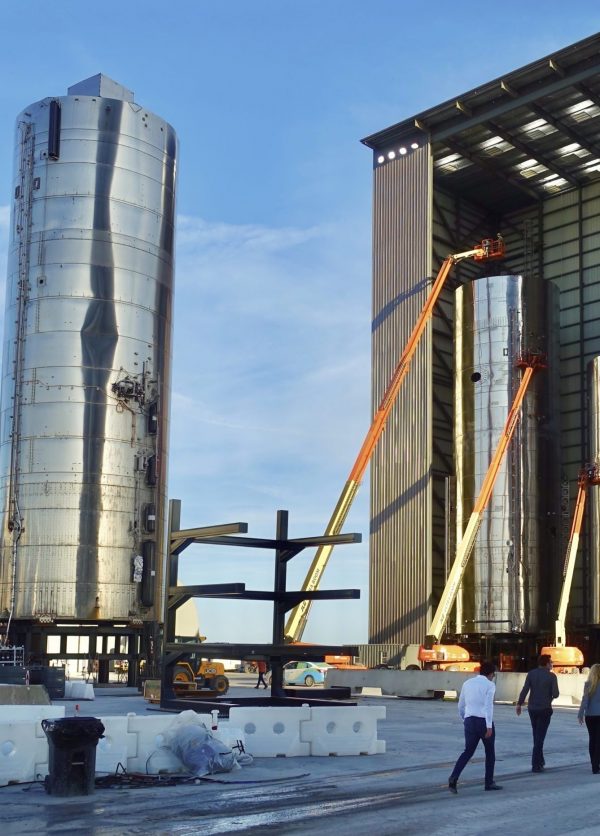
Image courtesy of Wikipedia.
An optimistic tweet from SpaceX CEO Elon Musk expressing hope the company can fly the Starship Heavy Lift Vehicle into orbit as soon as this month might have been based on more than just wishful thinking. Musk’s declaration coincided with the FAA receiving a favorable environmental report on SpaceX’s plans to expand the Starbase launch facility in Boca Chica, Texas.
Starship ready to fly in May
The tweet, which Musk posted March 21, 2022, described the extreme power of the company’s new generation of rocket motors and announced enough units were completed to send Starship on a test flight out of Earth’s atmosphere:
First Starship orbital flight will be with Raptor 2 engines, as they are much more capable & reliable. 230 ton or ~500k lb thrust at sea level.
We’ll have 39 flightworthy engines built by next month, then another month to integrate, so hopefully May for orbital flight test.
— Elon Musk (@elonmusk) March 21, 2022
Musk’s announcement came three weeks after the US Department of the Interior’s Fish and Wildlife Service – which conducted a detailed 141-page environmental review of SpaceX’s plans to expand launches in Texas – sent the document to the FAA for review. News that the draft BCO (Biological and Conference Opinion) was in the FAA’s hands came via an exclusive report from the broadcast network CNBC, which obtained it through a Freedom of Information Act request.
Risk to endangered species can be avoided
The report deals mainly with a group of endangered species living on the Starbase property and in the coastal wetlands surrounding it. The area is home to two species of endangered wildcats, the ocelot and the jaguarundi; as well as the northern Aplomado falcon; a pair of shorebirds, the piping plover and the red knot; and four species of sea turtles, the Kemp’s ridley, loggerhead, hawksbill, green and leatherback.
The Kemp’s ridley is the world’s rarest and most endangered sea turtle. Yet, risk to the Kemp’s ridley and other endangered species in the area can be mitigated by simple actions if expansion plans are approved, the report said. According to the Fish and Game’s cover letter for the BCO:
In the accompanying BCO, the Service determined that the action, as proposed, is not likely to jeopardize the continued existence of the species listed above. The action area encompasses a relative small portion of the rangewide habitat of each of the species addressed in this opinion and small portion of each species’ population.
Actions to lessen impacts on the at-risk species includes SpaceX-funded conservation of similar habitat elsewhere, fewer lights and less noise, monitoring how the species react to the upcoming changes and making sure “anomalies” in the form of crashed spacecraft and the resulting debris removal disturb the local wildlife as little as possible.
Shorebird habitat will be hardest hit
The species with the most to lose as SpaceX reaches for the moon and Mars is the piping plover. From the BCO:
The proposed action will result in the direct loss of 446.27 acres of piping plover habitat and critical habitat from construction and operation and the corresponding conversion of wind tidal flats. The proposed action will also result in an impact to 903.67 acres of occupied piping plover habitat and critical habitat in Critical Habitat Units TX-1.
The red knot also stands to see a large portion of its local habitat impacted by the proposed expansion. However, the 446.27 acres of red knot habitat that will be affected should be offset by Fish and Game’s plan to designate more than 680,000 acres elsewhere as critical habitat for the bird. The BCO describes a similar offset to protect the piper plover, which will see just 0.4 percent of its total habitat affected by SpaceX’s plans.
Perhaps most concerning is the report’s prediction of the impact to the extremely endangered Kemp’s ridley sea turtle, which could see the death of up to eight adults annually and the loss of three nests, along with as many as 330 hatchlings and eggs.
FAA, Fish and Game will be watching
Either the FAA or the Fish and Game Service could initiate a new environmental review of the Starbase site at Boca Chica if certain conditions arise, chief among them being the death of too many individual animals from the various species listed in the BCO.
A renewed environmental review could also be started if new negative effects on the at-risk animals are discovered, if new species are discovered to be affected by SpaceX’s operations or if the scope of review is modified in the future.
Should the number of endangered animals killed or harmed – known as the take – becomes too large, the controlling agencies will bring things to a halt. From the BCO:
In instances where the amount or extent of incidental take is exceeded, any operations causing such take must cease pending reinitiation.
Finally, the BCO could be the final biological report needed for SpaceX to fully begin upgrades at Starbase. From the BCO’s closing pages:
If the Service determines there have been no significant changes in the action as planned or in the information used during the conference, the Service will confirm the conference opinion as the biological opinion for the project and no further section 7 consultation will be necessary.
Bottom line: FAA environmental approval for expansion of SpaceX’s Starbase in Boca Chica, Texas could allow a test flight this month.
The post SpaceX may be back on target with Starship in Texas first appeared on EarthSky.
0 Commentaires